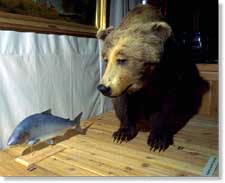 |
 |
|||
California on the Eve - Nature
Oh, the abundance of this land. Nature is and was the foundation of everything. California is a beautiful, dramatic, and biologically diverse land, which holds a richness of resources unmatched the world over. Picture the variety of California's natural settings - her fertile valleys, redwood forests, snow-capped mountains, canyons of rushing water, deserts, hills of chaparral, and rugged seacoast. Now, imagine how the discovery of gold might change this. The California grizzly bear once roamed in great numbers throughout parts of the state. California's Indians respected the grizzly and incorporated it into myths and traditional stories. Early Spanish explorers recorded sighting packs of grizzlies. One wrote: In this canyon were seen whole troops of bears. The grizzly was recognized as such a powerful and noble symbol that it became the official state animal of California. It is even the central figure on the state flag. What do you think happened to the California grizzly? It is now extinct. Edwin Bryant, a nineteenth century immigrant, remarked on the abundance of California's fish: I never saw a more beautiful stream. It abounds in fish. These salmon are the largest and fattest I have ever seen. I have seen salmon taken from the Sacramento five feet in length. American enterprise will soon develop the wealth contained in these streams. And Americans did! But they chose the wealth of gold over a wealth of fishes. They destroyed the habitats or caught many of the fishes that had been a mainstay of the diet of many California Indian tribes. C.A. Kirkpatrick reported on the fate of the salmon: In 1851, we could observe a great decrease. Like the poor Indian, they are being driven westward into the sea. During hydraulic mining in the 1870s and 80s the salmon population of California was reduced to near extinction. Top: Grizzley, Photo by Christopher Richard Nature | Californio | California Indian |
||||
|
||||
 Look at the magnificence of Yosemite in this
painting. John Muir wrote: Nearly all the upper basin of the Merced was displayed, with
its sublime domes and canyons, dark upsweeping forests, and glorious array of white peaks
in the deep sky. Never before had I seen so glorious a landscape.
Look at the magnificence of Yosemite in this
painting. John Muir wrote: Nearly all the upper basin of the Merced was displayed, with
its sublime domes and canyons, dark upsweeping forests, and glorious array of white peaks
in the deep sky. Never before had I seen so glorious a landscape.